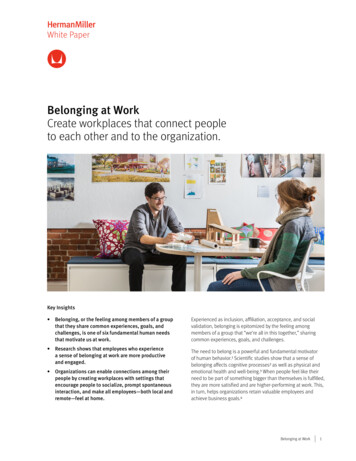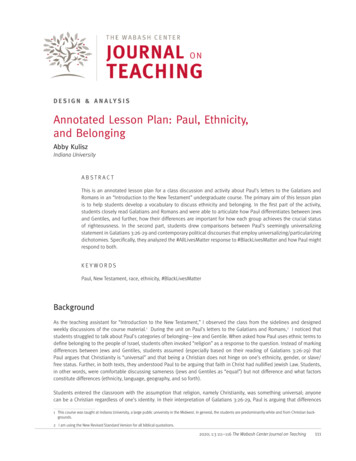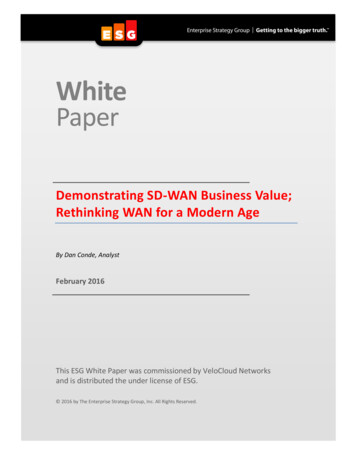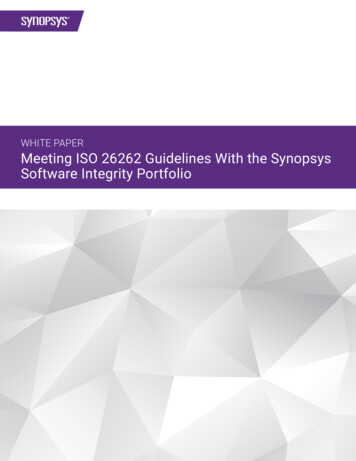
Transcription
White PaperBelonging at WorkCreate workplaces that connect peopleto each other and to the organization.Key Insights Belonging, or the feeling among members of a groupthat they share common experiences, goals, andchallenges, is one of six fundamental human needsthat motivate us at work. Research shows that employees who experiencea sense of belonging at work are more productiveand engaged. Organizations can enable connections among theirpeople by creating workplaces with settings thatencourage people to socialize, prompt spontaneousinteraction, and make all employees—both local andremote—feel at home.Experienced as inclusion, affiliation, acceptance, and socialvalidation, belonging is epitomized by the feeling amongmembers of a group that “we’re all in this together,” sharingcommon experiences, goals, and challenges.The need to belong is a powerful and fundamental motivatorof human behavior.1 Scientific studies show that a sense ofbelonging affects cognitive processes2 as well as physical andemotional health and well-being.3 When people feel like theirneed to be part of something bigger than themselves is fulfilled,they are more satisfied and are higher-performing at work. This,in turn, helps organizations retain valuable employees andachieve business goals.4Belonging at Work1
White PaperSuccessful and proactive organizations use their workenvironments to enhance belongingness by providing a varietyof settings that encourage social interaction and by carefullyplanning physical proximities, traffic paths, and sightlinesacross the landscape. Incorporating purposeful visual cues thatwelcome, engage, and inform a diverse employee populationalso promotes inclusion and esprit de corps.As part of our ongoing pursuit of human-centered design,Herman Miller’s Living Office helps organizations and theirdesign partners create environments that promote positivesocial experiences at work. Drawing on proprietary studiesconducted with our Living Office Research Partners,10 we’veidentified design considerations for settings throughout theworkplace that help people feel like they belong.The Belonging BreakdownMake Room for Socializing“Much of what human beings do is done in the service ofbelongingness.”5 A fundamental human motivation, theneed to belong shapes the way we think, feel, and behave.As a group, our Living Office Research Partners sharecharacteristics of healthy and engaged organizations; staffand leaders have a strong sense of purpose, belonging, andcommitment to their organizations. Before implementingLiving Office, Belonging Index scores (measured by level ofagreement with statements like “I feel a sense of belongingto my organization” and “I feel that I can be myself at work”)were already high (78 percent), and post-move averageswere even higher (83 percent).It’s a drive we come by naturally. From an evolutionary pointof view, social connection was basic to human developmentand survival. In early times, competition for limited resourcesand vulnerability to predators favored individuals who formedcooperative groups for hunting and protection.6 The bondbetween babies and the adults who provide for their basicneeds remains as essential to the species’ continuedexistence as access to food and water.7As a result, the human brain is wired for belonging; we’reprogrammed to seek positive social experiences just as we’redriven to satisfy our hunger or thirst. Recent studies inneuroscience indicate that social pain and pleasure use thesame neural mechanisms as those stimulated by physical painand pleasure. The brain treats real or potential separationfrom others just as it would a stubbed toe or a blow to thestomach and is unable to focus on anything else until the painis relieved. In contrast, connection—the giving or receivingof positive attention—stimulates the same reward centers aspositive physical experiences, like eating a favorite food.8 We’remotivated to pursue the experience over and over again.The desire to belong and fear of being excluded have importantimplications for individual and organizational performance.Social scientists studying school and work environments haveidentified “belonging uncertainty” as a major roadblock toperformance and achievement. As the authors of one studyput it: “One of the most important questions that people askthemselves in deciding to enter, continue, or abandon a pursuitis, ‘Do I belong?’”9 In environments where people continuallyquestion the quality of their social connections, this state ofbelonging uncertainty acts as a drain on energy and emotionalwell-being, and hampers productivity and motivation. But questions about the contribution of the new workenvironments to a general sense of belonging revealedsignificant improvement. Average agreement with thestatement “The design of the workplace contributes to asense of community at work” was a statistically significant27 percentage points higher post-move.One design strategy that our Research Partners employedwas to provide a variety of Living Office Cove Settings—suchas small, informal lounge areas or niches with standing-heighttables—that allow for casual interactions among employeesA small, comfortably furnished Cove Setting encourages impromptu conversations withoutdisrupting others’ work.Belonging at Work2
White Paperthroughout the workday. Research has well-established thepositive effect of face-to-face communication on teamperformance,11 and recent studies have begun to highlightthe neural mechanisms involved. One study measuring brainactivity and comparing the performance of workers in twodifferent call centers found that more informal chats facilitatedby an expansive community space—such as a Plaza Setting—hada positive effect on tasks involving “verbal working memory.”12contend that “meetings” are not discrete events, but rather“persistent conversation processes” that positively impact“social capital.”13 By purposefully placing Landing Settingswith café tables and chairs outside of Meeting Spaces,or by including Coves with comfortable lounge seating,organizations can encourage and support ongoingconversations and contribute to social bonding at work.Many of our Living Office Research Partners are strengtheninga sense of community at work by providing a comfortableand centralized place where people from all areas of theorganization can meet for informal interactions over coffee orfood. As one leader commented, “We have social gatherings inour new collective space, and it’s substantiated our cultureagain.” Other Research Partners who created Plaza Settings intheir new workplaces reported that these spaces have becomego-to spots for both work and socializing. “The café is a flexiblespace,” one staff member noted. “[I can use it to] focus ongetting work accomplished or just to have lunch and chit-chatwith the team.”A Landing Setting next to the formal Meeting Space provides a place to continueconversations and plan next steps once scheduled gatherings have ended.As the leader of one organization that implemented a LivingOffice design observed: “The balance between the workspaces,breakout spaces, and meeting rooms is facilitating the myriadtypes of interactions that happen during the day. Investingin creating the diversity of spaces where you actually havefacilitated social interactions has been transformative.”A centralized Plaza Setting brings people together from all parts of the organization andgives them an opportunity to connect as they share a meal or grab a cup of coffee.In addition to a centralized space designated for working andsocializing over food and drink, our Research Partners providea greater variety of settings, open and enclosed, where informalinteraction can take place. A recent study of the communicationthat happens between formal meetings and work sessionsfound that frequent face-to-face interactions were essential todeveloping social bonds among coworkers. The researchersTaken together, our Research Partners measured a statisticallysignificant 14-percentage point increase in agreementwith the statement “The design of the workplace allows meto interact informally with coworkers.” One respondentpointed to the mix of settings “which facilitates formal andinformal communication, as well as a sense of communityand camaraderie.”As psychologists have found, people “reserve particular,more extensive, and more favorable patterns of informationprocessing for people with whom they share social bonds.”14It all adds up to better communication and more effectiveinformation sharing.Belonging at Work3
White PaperPlan for ProximitySocial connection is essential to a feeling of belonging, andphysical proximity turns out to be a potent factor in creatingand maintaining this connection.In one landmark study, employees were asked to complete aproject with coworkers they believed to be located across thebuilding, across the nation, or across the globe. In actuality,all participants were in the same physical location, soproximity was purely a matter of perception. The study foundthat perceived distance had a significant impact on behavior:follow-through, openness, trust, and work completion wereall positively correlated with perceived proximity. People feltmore responsible and connected to people they believedwere located in the same building.15Our own global investigation of knowledge workers found“proximity to fellow workers”—along with support for “mobility”and “collaboration”—to be a significant feature of workplacesthat enhance a sense of belonging.Organizations can capitalize on the power of proximity bylocating team members and teams based on important workrelationships. Another strategy is providing settings wherecolleagues who are not situated near one another can meetup or run into each other on a regular basis. For example, aClubhouse Setting is a place where members of a highlycollaborative team have everything they need to work togetherin a centralized location. In this setting, a team can takeownership of its space, demonstrate its own identity, andestablish group norms. In addition, workplaces that offer visualaccess and convenient guest seating let passersby see andtake advantage of the moments when others are availablefor a quick chat.An essential aspect of belonging is helping and being helpedby other members of the group. A sense of inclusion increasesa person’s willingness to voluntarily assist others with workrelated problems. Studies show that those who offer help reapintrinsic rewards that include a sense of purpose as well asincreased feelings of belonging and community.16To promote opportunities for helpful connection, ensure thatsight lines are clear so coworkers can easily see one another.Provide furnishings that allow for convenient, spontaneousinteraction, and position Jump Space Settings—where anyonecan touch down to work for a few hours—near full-time teammembers. This will give part-time and contingent workers moreopportunities to seek assistance and learn from their coworkers.A drop-in Jump SpaceSetting encourages helpfulinteractions and informationexchange among full-timeand contingent workers.Belonging at Work4
White PaperAn inclusive environment thatsupports equal participationenhances a sense of belongingand strengthens commitmentto organizational goals.Cue InclusionIn today’s highly mobile and global business world, physicalproximity is not always possible. Important team members maybe located on the other side of the country—or the world. Evencolleagues from the same geographical location increasinglycommunicate via electronic devices rather than in person.Our increasing dependence on screen-based communicationhas led to a rapidly growing and measurable phenomenoncalled “virtual distance,” defined as “a sense of psychologicaland emotional detachment that begins to grow little by littleunconsciously when most encounters and experiences aremediated by screens on smart devices.”17In the absence of shared physical context and opportunities forinformal face-to-face communication, (including the loss ofnonverbal cues, spontaneous communication, and the abilityto take advantage of incidental meetings and learning) a senseof belonging deteriorates, along with cooperative and helpingbehaviors. When some team members are co-located andothers connect only virtually, an “us and them” situation maydevelop, leading to reduced trust and distorted perceptions.18Plan a workplace that combats virtual distance bycarefully selecting and placing digital screens. For example,videoconferencing set-ups that use separate monitors todisplay people and presentation materials—either digitallyor by placing analog materials like white boards within camerarange—allow remote participants to see what on-site viewersare looking at. Purposeful camera placement for effectiveeye-level viewing and capturing body language, facialexpressions, and eye movements can restore some of thelost benefits of face-to-face interaction.Furniture selection and arrangement within a Meeting Spacedesigned for videoconferencing can also help give remoteworkers “a seat at the table.” Tables and seating that allow allparticipants to share a common seated or standing posture andthat are configured to assure that no one is blocking anyone’sview can encourage equal participation in discussions andprovide more direct social connections for all.The degree to which people feel like they belong in theirphysical surroundings can affect their decisions to join orstay with an organization, as well as their performance whileworking there.19 An inclusive work environment plays anBelonging at Work5
White Paperimportant role in mobile and contingent workers’ senseof belonging. Studies show that people who work from homeor client-based locations report significantly lower rates of“workplace inclusion, defined as an individual’s sense ofbelonging, a perception that they are able to participate, andthat their opinions matter within the organization.”20For these employees, it’s important to provide a place they cancall “home” when they’re in the office. There are several waysto signal to mobile and contingent workers that they belong.Consider providing a drop-in Jump Space Setting located in ahigh-traffic area. Here, a shared work surface becomes a placewhere those who aren’t often in the office can work alongsidecolleagues and bump into people they don’t often see. Toenhance this approach, provide smart, connected furnishingsthat remember and respond to an individual’s preferences.These will help give people a sense of comfort and familiarity,even in a workplace where most workpoints are unassigned.Plan for ProsperityWhen workplaces provide a foundation for attachment,they contribute to employees’ feelings of connectionand engagement and—ultimately—to the success of theorganizations they work for. When individuals have astrong sense of belonging where they work, they aremotivated to cooperate, help each other, and share in therisks and rewards of the kind of creative thinking that willpropel corporate profitability to new heights. It all addsup to prosperity at the broadest and most personal levels.To learn more about how Living Office can workfor your organization and your people, visithermanmiller.com/livingoffice or connect with yourlocal Herman Miller representative who can engageyou with a Living Office Specialist.Belonging at Work6
White Paper1.Roy Baumeister and Mark Leary, “The Need to Belong: Desire for InterpersonalAttachments as a Fundamental Human Motivation.” Psychological Bulletin, 117(1995): 497-529.2.Matthew Lieberman and Naomi Eisenberger, “The Pains and Pleasures of SocialLife: A social cognitive neuroscience approach,” NeuroLeadership Journal 1 (2008):38-43, accessed July 27, 2017. pdf3.4.Edward Deci and Richard Ryan, “Autonomy and Need Satisfaction in CloseRelationships: Relationships Motivation Theory,” in Human Motivation andInterpersonal Relationships, ed. Netta Weinstein (Springer, 2014), 53-73.13. Keri Stephens et al., “Meetings as Persistent Conversations that use ICTs andFace-to-Face to Build Social Capital,” Proceedings of the 50th Hawaii InternationalConference on System Sciences (2017): accessed August 1, 2017, https://www.researchgate.net/profile/Keri Stephens/publication/312136230 Meetings asPersistent Conversations that use ICTs and Face-to-Face to Build Social Capital/links/5871388608aebf17d3aad565.pdf.14. Roy Baumeister and Mark Leary, “The Need to Belong: Desire for InterpersonalAttachments as a Fundamental Human Motivation.” Psychological Bulletin, 117 (1995):497-529.15. Karen Sobel Lojeski and Richard R. Reilly, Uniting the Virtual Workforce: TransformingLeadership and Innovation in the Globally Integrated Enterprise (Wiley, 2008), 11.Lauren Waardenburg, “The Influence of Commitment on Employee’s Sense ofBelongingness and the Consequences on Employee’s Turnover Intentions inHigh-Commitment Organizations,” SRC (2016): accessed July 31, 2017. .pdf.16. Nathaniel M. Lambert et al., “To Belong Is to Matter: Sense of Belonging EnhancesMeaning in Life,” Personality and Social Psychology Bulletin vol. 39 no. 11,1418-1427. November 2013.5.Roy Baumeister and Mark Leary, “The Need to Belong: Desire for InterpersonalAttachments as a Fundamental Human Motivation.” Psychological Bulletin, 117(1995): 497-529.17. Karen Sobel-Lojeski, “The Subtle Ways Our Screens Are Pushing Us Apart,” HarvardBusiness Review, (April 8, 2015) accessed August 3, 2017, s-are-pushing-us-apart.6.Roy Baumeister and Mark Leary, “The Need to Belong: Desire for InterpersonalAttachments as a Fundamental Human Motivation.” Psychological Bulletin, 117(1995): 497-529.18. Martin Johansson and Mattias Thiel, “We and the Others: How Leaders Can Bridge theGap in Dispersed Organizations and Partially Distributed Teams” PhD diss., JonkipingUniversity International Business School (2016): 10-11.7.Matthew Lieberman and Naomi Eisenberger, “The Pains and Pleasures of SocialLife: A social cognitive neuroscience approach,” NeuroLeadership Journal 1 (2008):38-43, accessed July 27, 2017. pdf8.Matthew D. Lieberman, Social: Why Our Brains Are Wired to Connect (Oxford, OUP,2013), 299-300.19. Sapna Cheryan et al. “Ambient Belonging: How Stereotypical Cues Impact GenderParticipation in Computer Science,” Journal of Personality and Social Psychology 97(2009): 1054; Aleah Warren, “What Signals Is Your Office Sending About WhoBelongs?” Medium (September 22, 2016) accessed August 3, 2017, 35.9.Gregory Walton and Geoffrey Cohen, “A Question of Belonging: Race, Social Fit, andAchievement,” Journal of Personality and Social Psychology, 92 (2007), 82-96.20. Valerie Morganson et al., “Comparing Telework Locations and Traditional WorkArrangements,” Journal of Managerial Psychology, 25 (2010): 579-595.10. This longitudinal, multi-method study captures qualitative and quantitative data—atpre-move and post-move phases—from the perspectives of employees, businessleaders, and professional researchers. The two data sets are then tested to measurethe impact of implementing Living Office.11. Alex Pentland, “The New Science of Building Great Teams,” Harvard BusinessReview, (April 2012), accessed August 2, 2017, g-great-teams.12. Jun-ichiro Watanabe et al. “Informal Face-to-Face Interaction Improves Mood StateReflected in Prefrontal Cortex Activity,” Frontiers in Human Neuroscience, 10(2016): accessed August 1, 2017, doi: 10.3389/fnhum.2016.00194.Z,Y, and Living Office are registered trademarksof Herman Miller, Inc., and its subsidiaries. 2017 Herman Miller, Inc., Zeeland, MichiganAll rights reserved.Belonging at Work7
The desire to belong and fear of being excluded have important . nonverbal cues, spontaneous communication, and the ability to take advantage of incidental meetings and learning) a sense of belonging deteriorates, along with cooperative and hel











